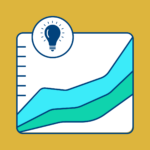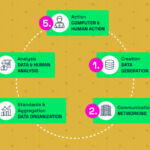
Data visualization is a hot topic for IoT right now. As more companies incorporate data-driven initiatives and innovation into their overall strategy and operations, the central importance of data visualization is growing. Service providers and end-users alike are beginning to recognize the distinctive value of data visualization tools for IoT applications. We’re learning how to draw new insight from previously “wasted” data.

I recently wrote an article on IoT for All about the importance of data visualization for the business and markets that are embracing connected or “smart” technologies. Thanks to growing demand, data visualization techniques and tools for IoT applications are gaining momentum rapidly. This post adds to the one above. Here, I’ll reveal some of the most powerful instruments used in data visualization for IoT applications and discuss criteria for choosing one over the other.
Power BI for Real-Time Data Visualization
Along with Tableau, Power BI is the jack-of-all-trades for IoT applications requiring data visualization. Originally, Power BI was an all-inclusive business intelligence tool that enabled companies to visualize a wide range of datasets. It has a comprehensive list of integrations, and it can pull data from many sources like Excel, Google Analytics, Salesforce, and social media platforms. As with most Microsoft products, Power BI is quite intuitive and has a reasonable learning curve. That being said, Power BI is a paid service.
Data Visualization for IoT Applications with Power BI
The burgeoning IoT market inspired Microsoft to expand Power BI’s capabilities to include real-time data visualization for IoT applications. Today, you can connect any IoT device, sensor, or application to the tool in order to stream data in real-time, making it a compelling choice not only for Azure-based projects but IoT projects built upon any major platform. Apart from a relatively easy set-up and dashboard building process, Power BI stands out for its unique verbal data management functionality. You can use natural language commands to query data, and voilà, Power BI will return relevant visualizations right on the screen—a win for non-technical users.
Benefits of Power BI
- Both streaming and static data
- Short learning curve
- Rich data visualization types
- Natural language data query
- New IoT integrations
Grafana for Metrics Visualization
Grafana is a professional data visualization and analytics tool specializing in the visualization of time-series analysis. Like Power BI, Grafana is known for its wide range of data visualization techniques, its vast capabilities for dashboard building and management, and its extensive list of possible data sources (e.g. AWS, Prometheus, and Elasticsearch).
Data Visualization for IoT Applications with Grafana
Grafana was originally designed for CPU and system health monitoring. But as mentioned above, the tool is better known for being one of the best tools for time-series data visualization. It’s quite popular in IoT and connectivity-focused verticals.
Grafana’s outstanding features include complex dashboard building, enabled alerts and notifications, custom filters, and annotation for streaming data. Grafana also allows you to personalize dashboards for different users. But no tool is perfect. Forget natural language querying, for example. Grafana lacks full-text querying and even requires a specific querying syntax for each data source.
Benefits of Grafana
- A wide range of data sources
- Perfect for metrics data
- Data management perks: custom filters, annotations, alerts and notifications sent to messengers or email
- Dashboards personalization for various user roles
Kibana for Logs Visualization
Kibana is a part of the Elastic Stack data management toolkit. It was designed specifically to visualize the time-series data from Elasticsearch clusters. It allows a wide range of data representations. It also includes maps and allows you to make custom visualizations, build complex dashboards, and share everything easily with teams, management, and even clients.
Data Visualization for IoT Applications with Kibana
Built on top of Elasticsearch, Kibana integrates directly into the Elastic Stack environment. However, direct integration has one major downside: Kibana is limited to the data coming from Elasticsearch.
The tool is nonetheless a good choice for IoT applications that require log visualization and analysis thanks to its ability to do “fuzzy matches” for data queries. Kibana also provides users with advanced visualization and data management features, including machine-learning techniques to detect and explore anomalies in datasets.
Benefits of Kibana
- Works for any type of time-series data
- Machine learning features
- Fuzzy match for data queries
- Easy setup and sharing
- Direct integration with Elastic Stack
Choosing the Right Data Visualization Tool
[bctt tweet=”‘Clarifying the objectives of your data visualizations matters above all. It’s important first to identify goals and needs and only then to explore the different data visualization platforms. Following this process will help to ensure that you choose the best-suited platform.'” username=”iotforall”]
First of all, if the company already uses a particular data management tool for some purposes, it usually makes sense to build data visualization for a new IoT project using the same tool or at least one that’s compatible with the pre-existing data ecosystem.
For example, if the company relies on Elastic Stack for system performance monitoring, it’s probably a good idea to use Kibana due to its direct integration with the Elastic Stack. On the other hand, it’s easier for businesses using AWS to integrate with Grafana rather than move to other data ecosystems. However, if the company needs to go beyond time-series data visualization, more versatile tools like Tableau or Power BI are probably good choices. It’s a balance between what came before and what you intend to do with the data visualization.
Kibana will suit any project involving the visualization of logs or metrics, while Grafana works best for projects restricted to metrics visualization. Grafana is also great for applications that require personalized dashboards for different users, whereas Kibana enables building and sharing unified dashboards for all user categories.
Both Kibana and Grafana were specifically designed for time-series data analysis. As such, they provide a wide range of visualization perks for time-series analysis. Moreover, these tools are open-source and cost nothing.
Clarifying the objectives of your data visualizations matters above all. Ask yourself, What goals am I trying to achieve by visualizing these data? What do I hope to show people? It’s important first to identify goals and needs and only then to explore the different data visualization platforms. Following this process will help to ensure that you land on the tool that best suits your unique needs.





 New Episode
New Episode





 Latest IoT News
Latest IoT News









